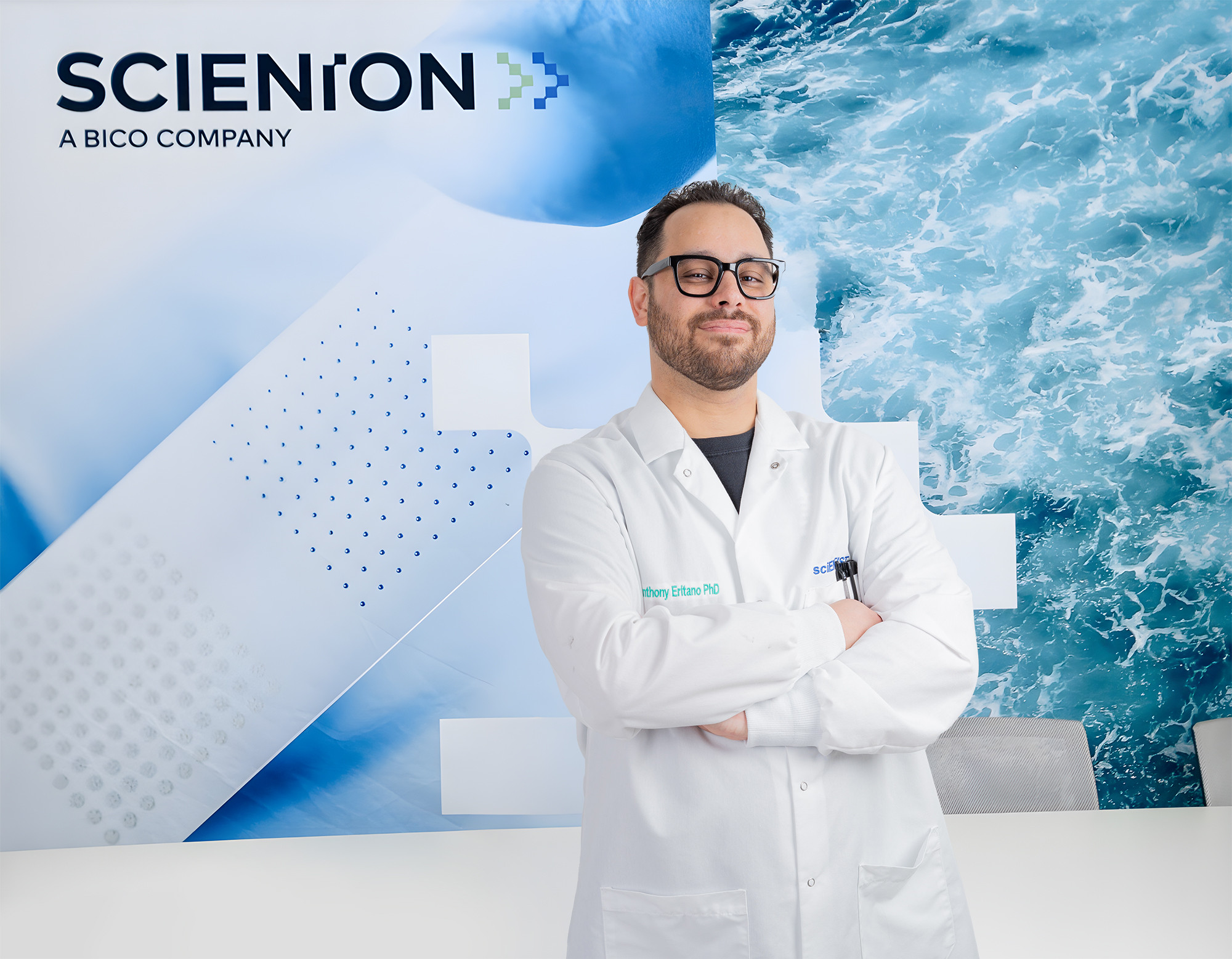Get to know SCIENION: Anthony Eritano, Application Scientist & EHS Manager

Apart from working on assay development projects, our global team of application scientists supports cutting-edge research in other fields of life sciences. Vision-assisted precision dispensing is the backbone of the cellenONE product line for single cell isolation and spheroONE instrument for dispensing and isolation of 3D cellular models like spheroids, organoids, and tumoroids. In combination with dedicated consumables, these technologies enable innovative transcriptomic and proteomic workflows.
Anthony Eritano holds a Ph.D. in Developmental Biology and Embryology with a background in Cell and Molecular Biology. His work plays a crucial role in both – application related projects and daily operations at SCIENION US.
Q: What do you do at SCIENION?
A: I am a man who wears many hats at SCIENION. I was hired in April 2021 to be part of the Field Applications team, with emphasis on supporting cellenONE installation and training. I was transferred to Contract Development as an Application Scientist in May 2022, to help provide cell culture support for the increase in single cell application demos. I now maintain the cell culture facility at the Phoenix location and work on internal projects using the cellenONE in addition to working on multiple collaborations with industry leaders and academic institutions. With the arrival of the spheroONE to the Phoenix facility, I have been dedicating time to optimize our in-house spheroid formation and working on multiple collaborations using the spheroONE to isolate single spheroids for proteomic and genomic studies.
I also oversee the environmental health and safety program at our Arizona locations. With my 10+ years of experience with the Occupational Safety and Health Administration (OSHA), I was able to develop a comprehensive safety program to ensure our employees work safely and that SCIENION US is kept in compliance with local, state, and federal regulations.
In addition to being an Application Scientist and Safety Officer, I also ensure that our Contract Development Service Lab runs smoothly from behind the scenes. I make sure all hazardous waste is managed and disposed of properly, supplies are kept in stock within the lab, write SOPs and Work Instructions for the lab processes, and repair and maintain equipment in the lab.
I am a jack of all trades, master of none… but often times better than a master of one.
Q: What kind of projects are you currently working on?
A: I have multiple projects happening at any given moment. My focus of my projects revolves around the specific applications of the cellenONE and spheroONE that are of interest in academia and industry.
A couple noteworthy applications I am working on is using the cellenONE to assist in the genetic and proteomic profiling of human iPSC through the process of differentiation. Another project using the cellenONE involves examining and profiling the secretome (molecules released from the cell into the media or surrounding environment) and their effect on acquired resistance to chemotherapeutic drugs. Both projects with the cellenONE have the potential to provide a greater understanding of how cells differentiate and a better understanding of how cells can become resistant to chemotherapeutics and how clinicians can counteract medication resistance.
Right now, there has been a huge interest with the spheroONE and the isolation of spheroids and organoids. Similar to the acquired chemotherapeutic drug project with the cellenONE, I am working with a collaborator on understanding the secretome and exosome composition of spheroids. This project can provide a great deal of information about the establishment of tissue specific niches, and how tissues interact with each other. The final spheroONE project I want to mention is being performed in collaboration with my application colleagues at Cellenion’s headquarters in Lyon, France. This project involves examining the genetic changes found inside the cells of organoids. These changes can provide genetic and proteomic data on how cells destined to become a specific tissue, interact with their neighboring cells to become more specialized structures. This allows future researchers to know what molecular signals are needed to get specific functional structures.
Q: How long have you been part of the SCIENION team?
A: I started in April 2021, so I have been with SCIENION for two years.
Q: What’s your favorite thing about your job?
A: My favorite aspect of working at SCIENION, is the new projects and areas of interest that are happening in Industry and Academia. I feel that I am on the cutting edge of many interesting and potentially groundbreaking projects that can benefit everyone. Working at SCIENION allows me to explore new technical applications and solutions to everyday mundane procedures that take place in a laboratory setting. I am given the freedom to approach my internal R&D projects in a way that I feel is the correct path.
Q: What does your day at SCIENION consist of?
A: The main work I do every day is slightly different, depending on what project I am currently working on. But I have streamlined most of the repetitive tasks to set days. On Mondays, I do brief safety inspections of equipment, check the functionality of machines around the lab, and plan out my experiments for the week. I have regular meetings with our Lab Director about project planning and timelines for our current projects and collaborations. Since most of my work is cell-based I spend the vast majority of my time in cell culture, either prepping or maintaining samples or performing runs on the cellenONE and spheroONE.
